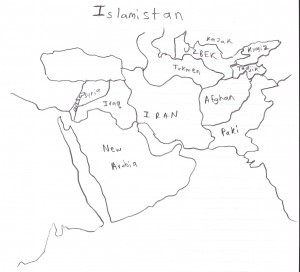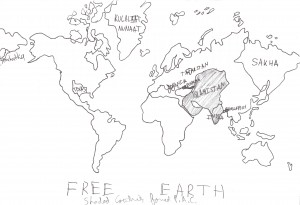This back story continues from the end of The formation of United Earth
Taken from “The Definitive History of the Planet Earth, Volume II – The Middle Era: Struggle for Planethood.”
This excerpt deals with the conflict between rival world government organizations.
The nations of Free Earth worked fast, creating a splinter UN headquarters in Mecca and forming a “world” court in Houston. Free Earth nations controlled some important strategic locations, including the Gulf of Mexico, the Indian Ocean and the Suez Canal. They also spanned the globe. “The sun never sets on the Free Earth”, was a popular slogan They began as a resistance coalition trying to pressure the UE to dissolve and return to the UN. However a special Council of the Seven Continents, called by the UE, but operated through the continental unions, issued a resolution declaring all Free Earth nations to have withdrawn from the UN and henceforth considered “bandit countries.”
The “bandit” label had been used during the American Wars to label terrorist organizations. There had been no actual armed conflicts in 123 years, so the use of this provocative term was shocking to many. It served to further harden the resolve of Free Earth nations. The Texas President in his official response said, “War is on your lips. Let’s hope it is not in your hearts.”
What scared the UE the most was that FE had a major space port, and could work its pressure through landing a rival Moon party. This would be expensive and difficult and without the cooperation of UE members, but it could be done. Conflict in space, avoided for centuries, could happen after it was though conflict on the planet had been ended for good.
The old United Nations continued, but without Free Earth members, it seemed duplicated and overshadowed by UE. The arguments for keeping it alive included the importance and entrenchment of many of its humanitarian efforts. The likely more practical reason was using it as leverage against Free Earth. The thinking went that FE nations would more likely join the old UN than UE, but once int he UN pressure could be brought to bear to get them into UE. It turned out the UN was not needed in UE’s first success story.
The weakest link for FE was Tatarstan which was entirely surrounded by Russia. When the UE put an embargo on FE countries Tatarstan felt it the most. After two years of what the media dubbed “The Second Cold War”, Tatarstan joined the UE as part of the European delegation and was ejected from Free Earth.
Meanwhile the UE, with the tantalizing bait of extra delegates, convinced the Chinese-dominated Asian Confederation and Pacifica to convert their representatives to freely elected delegates rather than national representatives. Europe, Africa and South America had already made the change with some delegates chosen from areas that crossed national boundaries. Only North America still had national representation. In fact, the change had some unexpected results in Africa, where some national governments had dissolved in favor of smaller tribal organizations centered around their local UE delegate.
In South America, national governments came to be viewed as local councils. This eventually led to the elimination of regional election of UE delegates. Citizens voted as South Americans for 10 delegates in a ranked choice system. The 14 candidates ranked highest, went to the UE headquarters in New York. Some special weighting was given to minority representation such as Anglos, and Native Peoples.
 The loss of Tatarstan caused a unity crisis in Free Earth. Islamistan convinced Bangladesh and India to support a motion for Free Earth nations to rejoin the old UN, feeling this would prevent another situation where a nation would feel it had no choice but to join the UE. UE now supported letting FE nations back in the UN as a way of pressuring FE into closer alignment. Texas, Sakha, and Kamchatka led the opposition claiming any compromise with the UE undermined the very existence of Free Earth.
The loss of Tatarstan caused a unity crisis in Free Earth. Islamistan convinced Bangladesh and India to support a motion for Free Earth nations to rejoin the old UN, feeling this would prevent another situation where a nation would feel it had no choice but to join the UE. UE now supported letting FE nations back in the UN as a way of pressuring FE into closer alignment. Texas, Sakha, and Kamchatka led the opposition claiming any compromise with the UE undermined the very existence of Free Earth.
UE proposed arbitration to decide the issue, but FE voted 8-1 against with only Albania supporting. The UE’s main concern was that seven of the nine FE countries (all but Chechnya and KN) had nuclear weapons. All nations had assured UE at the formation of FE that the missiles were still pointed out into space as required by the Global Missile Treaty of 2011. But not everyone trusted FE.
With tensions rising, Chechnya suggested a compromise for all by allowing FE nations into the UN, but creating a council of six continental reps. and three representatives from FE. The old UN would be formally dissolved and the new UN would focus only on significant disputes, thus cutting the cost and bureaucracy of keeping the old institution in place. Both the Texas and Islamistan coalitions agreed to this proposal if the UE was limited to three representatives, rather than six. The UE balked saying that the council could then only resolves disputes between FE and UE, and there were some other issues, like climate and disease among others, that didn’t involve direct FE-UE conflict that might need the voices of the entire world to weigh in on.
Texas firmly resisted saying they would only support an equally split council of six which would only resolve disputes between UE and FE. Their counter-proposal suggested leaving current UN efforts in place to deal with disease, hunger, climate and other things like that. The UN’s governing efforts would be shut down and the remaining organizations would have appeal to the newly formed council of six. And so the World Council was born. Its first council seats went to Texas, Islamistan, Chechnya, Africa, South America and Pacifica.
The back story continues with The Hot War
